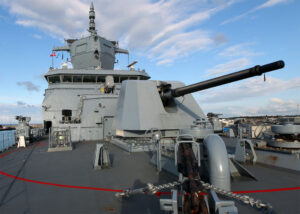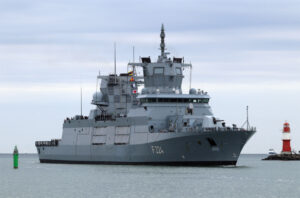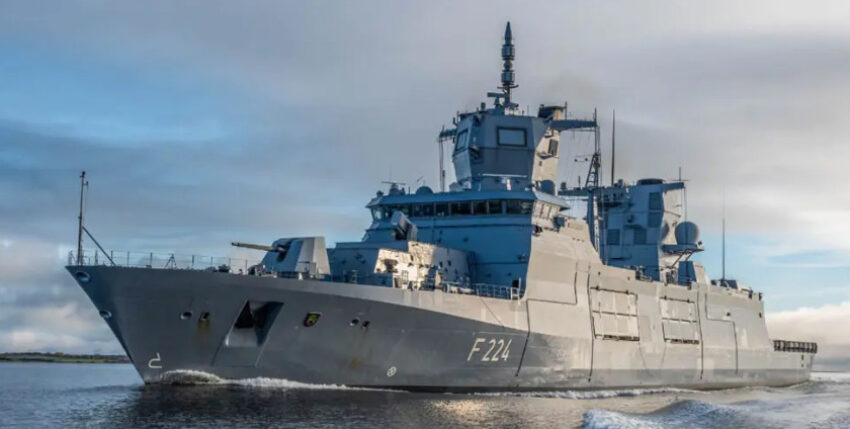A few weeks ago, the RHEINLAND-PFALZ, the fourth and last Class 125 frigate, was commissioned. Time for a look at the problems and successes of this huge project to date.
Two high-profile events at the beginning of 2022 were emblematic of the progress made by the Class 125 frigates: firstly, the fourth and final ship of the class, the RHEINLAND-PFALZ, was accepted by the industry on 28 January, and secondly, a ship of the class was involved in the German Navy's "flag flying" in the Baltic Sea at the beginning of March in connection with the Ukraine conflict.
The Class 125 is now not only a familiar sight in the North Sea, but is still frequently to be found undergoing trials in the Baltic Sea - an unmistakable sign that the realisation of the project is well advanced, but not yet complete. At the same time, the shipyard period for the first major scheduled overhaul of the type ship BADEN-WÜRTTEMBERG in Bremerhaven is coming to an end. It is therefore the right time to take stock of the largest German naval project realised to date and to provide an outlook on the path to achieving operational readiness for the class.
The F 125 project, which was launched in 2007 with the construction contract, has gone through some ups and downs and faced numerous project disruptions (see marineforum 5-2020). The new conceptual approach of intensive usability and the multi-crew concept as well as the focus on new deployment scenarios with asymmetric threats, sea-to-shore operations and support from special forces meant a considerable need for innovation, which entailed time-intensive, risky development efforts by the industry. At the same time, the project environment has fundamentally changed in terms of regulations, procedures and tools during project realisation - with a significant impact on supply maturity performance, information security and system approval. The increased number of parties involved in the process resulted in a significant increase in the coordination effort.

Testing and verification
In April 2016, the sea trials of the BADEN-WÜRTTEMBERG class began with the shipyard sea trials. After completing the proof of function for the operational system, the BADEN-WÜRTTEMBERG was accepted by the industry on 30 April 2019 and put into service on 17 June 2019. This was followed by an initial phase of operational testing from the end of July 2019 to April 2020.
While the ship technology was already at a good level of maturity at this time, there was a relevant need for further development in the deployment system due to the degree of innovation, complexity and high level of networking. This was gradually eliminated with the subsequent ships, which were delivered at roughly the contractually agreed one-year intervals. The biggest technical challenge was the Kora 18 electronic warfare system, which had to undergo a comprehensive reengineering from 2018. The first expansion stage was demonstrated in the functional verification of RHEINLAND-PFALZ in autumn 2021. The final second expansion stage successfully completed the performance tests this spring and the proof of function will be finalised in summer 2022.
The path to operational readiness
This also lays the foundation for further testing of the weapon function chains and the remaining parts of the operational test, which will be concluded with a missile and 127-millimetre firing in autumn 2022. The long-range Vulcano ammunition will also be demonstrated. At the same time, the IT systems of the second ship, the NORDRHEIN-WESTFALEN, will be hardened for the first time in accordance with the requirements of the German Federal Office for Information Security (BSI). The system components that have been verified on the frigates RHEINLAND-PFALZ and NORDRHEIN-WESTFALEN will be transferred to the frigate BADEN-WÜRTTEMBERG once the maintenance phase has been completed. The parallelisation of activities serves to reduce risk at an early stage and follows a sophisticated schedule that always releases one ship - currently the SACHSEN-ANHALT - for the necessary naval training phases. The final measures required for information security will then be implemented in the second quarter of 2023 with the frigate BADEN-WÜRTTEMBERG. With the accreditation by the German Military Security Authorisation Agency (DEUmilSAA) scheduled for July 2023, the Navy will have the first operationally ready F 125 class ship at its disposal.
System development: Lessons learnt
The development of complex components within the actual shipbuilding project by the same project team proved to be extremely challenging for both the public client and the industry. In addition to Kora 18, this included large systems such as the main armament (127 mm large calibre gun), the main sensor (TRS-3D multifunction radar), the IFF system (Identification Friend or Foe), the heavy machine gun and the buster boats.
Due to their complexity, each of these components would have warranted realisation as a separate project. If these developments take place within the actual shipbuilding project with its limited personnel capacities, they quickly lead to project risks that can no longer be easily mitigated. Neither the industry coordination nor the monitoring of these sub-projects by the public client can then be guaranteed in the required depth.
If some of these components, such as the 127-millimetre gun, also have to be provided to the main contractor Arge F 125 on time and free of defects, then the contracting authority shares in the realisation responsibility of the main contractor. It is then both the client for the overall weapon system and the subcontractor for the component to be provided, and contractual conflicts cannot be ruled out.
It is now possible to organise system networks of several projects within the framework of programme management. This means that the capabilities to be realised can be broken down into different levels of complexity and still be organised to achieve the overall objective. Last but not least, however, market-available equipment and systems should increasingly be used in the context of combat ship projects.

Information security
Due to the reduced crew concept, the frigate 125 has a high degree of automation and networking, combined with a large number of IT systems. Many of these IT systems process classified information and therefore have to undergo an accreditation process. In particular, the radiation measurements of these components, which have to be repeated every six years, represent a major challenge with a high time requirement due to the sheer number - in the case of F 125 this concerns around 750 devices. For purely practical reasons, the measurements can only be carried out sensibly within the framework of maintenance idle times, but extend these by several months. Once the results of the BADEN-WÜRTTEMBERG overhaul are available, the costs and benefits will have to be discussed again with the parties involved in the process.
As frigate projects have a long realisation phase of around 15 years, whereas the innovation cycles of commercial IT are only five to seven years, obsolescence is an inherent part of every major project. They complicate the accreditation process, as recognised security gaps can often no longer be closed. Regenerations can only be carried out in agreement with the main contractor via contract amendments. After the end of the design phase, however, this is often only possible to a very limited extent. This means that system adaptations such as revised configuration specifications can usually only be implemented after acceptance.
In general, it makes sense to reduce the number of different IT systems across all classes in order to reduce the necessary maintenance effort to a manageable level. With regard to the F 125, such an approach could be made the premise for a midlife conversion in the early 2030s. This could be implemented by harmonising the structural condition of the F 125 with the F 126, which will then be phased in. The two ship classes have similarities in terms of sensors and effectors, particularly in the operational system, meaning that the IT systems used on the F 126 could also be used on the F 125. To this end, more in-depth analyses will need to be carried out over the next few years, taking into account the progress of the F 126 project on the one hand, but also the general approach to standardising maritime command and control systems on the other.
Supply maturity
Analogue to the intensive usability and multi-crew concept, new ground was also broken in the area of supply maturity. For the first time, a large weapon system is to be managed exclusively via SASPF (Standard Application Software Product Family) and the consistent, consecutive application of the ASD S2000M (material data) and S1000D (interactive electronic technical documentation) standards to create the basis for end-to-end logistics - from material analysis at the start of the project (Logistic Support Analysis, LSA) through to post-supply and repair - at the manufacturers.
The goal of complete management in SASPF has now been achieved, but the road to this goal was paved with a number of obstacles:
- Lack of experience on the part of both the öAG and the industry with regard to the application of ASD standards
- Delayed availability of required tools for mass transfer of material data to SASPF
- the connection of floating platforms to SASPF still had to be created (Log IT-U F125 project)
- Roll-out of SASPF for the naval arsenal to enable breakpoint-free processing of maintenance processes
The goal of end-to-end logistics still requires the following steps:
- Although the sequential application of S2000M and S1000D standards defined in F 125 meets the requirements of the Integrated Logistic Support Suite Bw (ILS) planned for 2026, it has not yet found its way into the higher-level directive and is therefore not specified for subsequent projects.
- The direct selection and definition of material classifications from approved S2000M material information developed as part of F 125 is currently being coordinated with the parties involved in the process.
- The application of the ASD 2000M standard for information exchange in use has not yet been agreed with the manufacturers.
Maintenance In SASPF
Another new feature of F 125 is the complete mapping of maintenance in SASPF. To do this, the maintenance measures contained in the technical documentation for all maintenance levels must be read out, processed and transferred to maintenance plans in SASPF. A maintenance database is used as a planning tool for this purpose, in which the measures are optimised with a view to minimising restrictions on the availability of the weapon system over the operating period. Based on this ship class-specific definition, the measures are transferred to maintenance plans in SASPF - currently still manually.
Conclusion
In many respects, the F 125 is a flagship project in the field of naval combat ships. It was exhausting, led to delays, but ultimately resulted in forward-looking solutions:
Application of the ASD S2000M 4.0 and ASD S1000D 2.3 standards including new testing tools
- Connection of floating platforms to SASPF
- Replacement of old logistics processes
- Realisation of intensive usability and multi-occupancy concept
- Accreditation InfoSich
- First application of the reorganised authorisation system
Follow-up projects (K 130 2nd batch, F 126, F 127, FDB 424, BVS, U 212CD) can adopt the results developed in F 125 and build on them. The lessons learnt were developed and communicated during the project and taken into account in the contracts and specifications.
Last but not least, the innovative systems such as the TRS-3D NR multifunction radar, Kora 18 or LCG 127 millimetre provide the basis for the development of product lines that will be adopted or further developed by F 126, so that a higher degree of cross-sectional capability will be achieved again in surface combatants in the future.
The main risks in the project have been minimised, the residual risks are manageable and the schedule has been agreed with all parties involved. This gives the navy the planning security it needs, especially with regard to the flagstaffs required to fulfil its operational tasks. The BADEN-WÜRTTEMBERG will be the Navy's first ship ready for deployment from July 2023, with the other ships following by the end of 2024.
Chief Technical Government Director Marc Steffens is Project Manager Frigate 125, Technical Government Director Axel Wriedt is Integrator Operational System F 125, Frigate Captain Andreas Jedlicka is Integrator Supply Maturity F 125. The authors work at the Federal Office of Bundeswehr Equipment, Information Technology and In-Service Support.
Marc Steffens, Axel Wriedt and Andreas Jedlicka










